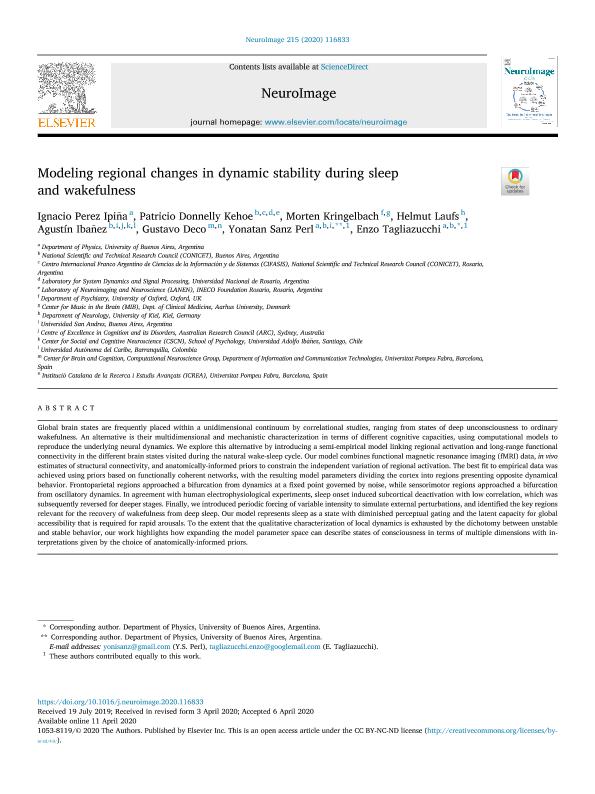Artículo
Modeling regional changes in dynamic stability during sleep and wakefulness
Perez Ipiña, Ignacio Martin; Donnelly Kehoe, Patricio Andres ; Kringelbach, Morten; Laufs, Helmut; Ibañez, Agustin; Deco, Gustavo; Sanz Perl Hernandez, Yonatan
; Kringelbach, Morten; Laufs, Helmut; Ibañez, Agustin; Deco, Gustavo; Sanz Perl Hernandez, Yonatan ; Tagliazucchi, Enzo Rodolfo
; Tagliazucchi, Enzo Rodolfo
 ; Kringelbach, Morten; Laufs, Helmut; Ibañez, Agustin; Deco, Gustavo; Sanz Perl Hernandez, Yonatan
; Kringelbach, Morten; Laufs, Helmut; Ibañez, Agustin; Deco, Gustavo; Sanz Perl Hernandez, Yonatan ; Tagliazucchi, Enzo Rodolfo
; Tagliazucchi, Enzo Rodolfo
Fecha de publicación:
15/07/2020
Editorial:
Elsevier
Revista:
Journal Neuroimag
ISSN:
1053-8119
Idioma:
Inglés
Tipo de recurso:
Artículo publicado
Clasificación temática:
Resumen
Global brain states are frequently placed within a unidimensional continuum by correlational studies, ranging from states of deep unconsciousness to ordinary wakefulness. An alternative is their multidimensional and mechanistic characterization in terms of different cognitive capacities, using computational models to reproduce the underlying neural dynamics. We explore this alternative by introducing a semi-empirical model linking regional activation and long-range functional connectivity in the different brain states visited during the natural wake-sleep cycle. Our model combines functional magnetic resonance imaging (fMRI) data, in vivo estimates of structural connectivity, and anatomically-informed priors to constrain the independent variation of regional activation. The best fit to empirical data was achieved using priors based on functionally coherent networks, with the resulting model parameters dividing the cortex into regions presenting opposite dynamical behavior. Frontoparietal regions approached a bifurcation from dynamics at a fixed point governed by noise, while sensorimotor regions approached a bifurcation from oscillatory dynamics. In agreement with human electrophysiological experiments, sleep onset induced subcortical deactivation with low correlation, which was subsequently reversed for deeper stages. Finally, we introduced periodic forcing of variable intensity to simulate external perturbations, and identified the key regions relevant for the recovery of wakefulness from deep sleep. Our model represents sleep as a state with diminished perceptual gating and the latent capacity for global accessibility that is required for rapid arousals. To the extent that the qualitative characterization of local dynamics is exhausted by the dichotomy between unstable and stable behavior, our work highlights how expanding the model parameter space can describe states of consciousness in terms of multiple dimensions with interpretations given by the choice of anatomically-informed priors.
Palabras clave:
Whole-Brain Models
,
Neuroscience
,
Non-linear dynamics
,
Human Sleep Stages
Archivos asociados
Licencia
Identificadores
Colecciones
Articulos(SEDE CENTRAL)
Articulos de SEDE CENTRAL
Articulos de SEDE CENTRAL
Citación
Perez Ipiña, Ignacio Martin; Donnelly Kehoe, Patricio Andres; Kringelbach, Morten; Laufs, Helmut; Ibañez, Agustin; et al.; Modeling regional changes in dynamic stability during sleep and wakefulness; Elsevier; Journal Neuroimag; 215; 116833; 15-7-2020; 1-13
Compartir
Altmétricas



